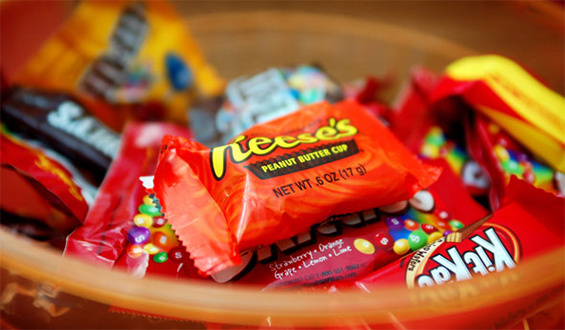
By now, parents are creating ways to ration out all that candy their kids accumulated on Saturday night. Diving into the candy bag is inevitable, but parents want the indulgence to be moderate, writes CBC News Windsor, Canada.
Sarah Woodruff, an associate professor of kinesiology, specializing in health and wellness and body weight management at the University of Windsor, says with bite-sized chocolate bars containing 60 to 100 calories each, the number of pieces given to a child should vary according to the child’s age.
Woodruff calls the large “haul” of candy a teachable moment. Children can learn about moderation and sharing.
“Kids can keep half the candy and get rid of the other half,” she said. “I’ve also heard of parents allowing their children to keep only their favorite treats and getting rid of the rest. “Teach children to enjoy the treats, rather than just stuffing their face full.”
The Ontario Dental Association suggests keeping the candy in a sealed container and scheduling time for your child to have a treat. They add that parents should give treats after a meal since the amount of saliva will help protects kids’ teeth, and advise kids to keep up the routine of brushing and flossing twice a day. Suggestions also include using sugarless gum when away from home to help get saliva flowing and alternating vegetable, fruits, yogurts, and cheeses with Halloween treats.
Jill Castle, a dietitian, nutritionist and childhood nutrition expert, writes for CNN that kids should only consume around 10% of their daily caloric allotment in the form of sugar. Unfortunately, many children are shooting past that recommendation, and not only on Halloween.
The CDC reports that 16% of boys’ daily caloric intake is from added sugar. For girls, the sugar intake is about 15% – and that sugar amount can even come in what seems to be “healthy” food including yogurt and sugar. The solution is not as easy as strictly controlling certain foods like sweets. Research has shown that doing so may cause those foods to become even more desirable for children.
Infants and toddlers truly do not need to have any sugary treats, Their needs for high nutrients and their small stomachs make every bite of food they take in daily essential to their development.
Woodruff says in her family the candy went in the freezer and was finally forgotten and thrown away.
Other ways to get rid of candy is to take the candy away and leave a new toy, a method called Switch Witch. Another is a buy-back program that allows children to sell their candy to their dentist who ships it to troops overseas.
Julie Gunlock of the New York Post writes that Halloween is a dinosaur, meaning that parents in years past knew there were times when it was appropriate to bend the rules a bit and have a good time. Today’s parents need to relax a little and realize that one night of festivity is not going to result in long-term harm, she says.
There is even a name for this condition: orthorexia. This worry is an “unhealthy fixation on eating healthy and consuming only certain types of food.” But Halloween, events, and other holidays where sugar-filled treats are a central part do not cause childhood obesity, says Gunlock. Instead, they create joy, fun, and happy memories, which are essential for kids.




